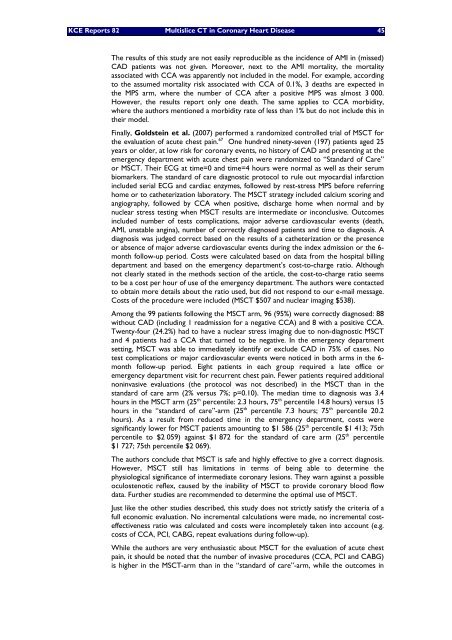Download the full report (116 p.) - KCE
Download the full report (116 p.) - KCE
Download the full report (116 p.) - KCE
Create successful ePaper yourself
Turn your PDF publications into a flip-book with our unique Google optimized e-Paper software.
<strong>KCE</strong> Reports 82 Multislice CT in Coronary Heart Disease 45<br />
The results of this study are not easily reproducible as <strong>the</strong> incidence of AMI in (missed)<br />
CAD patients was not given. Moreover, next to <strong>the</strong> AMI mortality, <strong>the</strong> mortality<br />
associated with CCA was apparently not included in <strong>the</strong> model. For example, according<br />
to <strong>the</strong> assumed mortality risk associated with CCA of 0.1%, 3 deaths are expected in<br />
<strong>the</strong> MPS arm, where <strong>the</strong> number of CCA after a positive MPS was almost 3 000.<br />
However, <strong>the</strong> results <strong>report</strong> only one death. The same applies to CCA morbidity,<br />
where <strong>the</strong> authors mentioned a morbidity rate of less than 1% but do not include this in<br />
<strong>the</strong>ir model.<br />
Finally, Goldstein et al. (2007) performed a randomized controlled trial of MSCT for<br />
<strong>the</strong> evaluation of acute chest pain. 67 One hundred ninety-seven (197) patients aged 25<br />
years or older, at low risk for coronary events, no history of CAD and presenting at <strong>the</strong><br />
emergency department with acute chest pain were randomized to “Standard of Care”<br />
or MSCT. Their ECG at time=0 and time=4 hours were normal as well as <strong>the</strong>ir serum<br />
biomarkers. The standard of care diagnostic protocol to rule out myocardial infarction<br />
included serial ECG and cardiac enzymes, followed by rest-stress MPS before referring<br />
home or to ca<strong>the</strong>terization laboratory. The MSCT strategy included calcium scoring and<br />
angiography, followed by CCA when positive, discharge home when normal and by<br />
nuclear stress testing when MSCT results are intermediate or inconclusive. Outcomes<br />
included number of tests complications, major adverse cardiovascular events (death,<br />
AMI, unstable angina), number of correctly diagnosed patients and time to diagnosis. A<br />
diagnosis was judged correct based on <strong>the</strong> results of a ca<strong>the</strong>terization or <strong>the</strong> presence<br />
or absence of major adverse cardiovascular events during <strong>the</strong> index admission or <strong>the</strong> 6month<br />
follow-up period. Costs were calculated based on data from <strong>the</strong> hospital billing<br />
department and based on <strong>the</strong> emergency department’s cost-to-charge ratio. Although<br />
not clearly stated in <strong>the</strong> methods section of <strong>the</strong> article, <strong>the</strong> cost-to-charge ratio seems<br />
to be a cost per hour of use of <strong>the</strong> emergency department. The authors were contacted<br />
to obtain more details about <strong>the</strong> ratio used, but did not respond to our e-mail message.<br />
Costs of <strong>the</strong> procedure were included (MSCT $507 and nuclear imaging $538).<br />
Among <strong>the</strong> 99 patients following <strong>the</strong> MSCT arm, 96 (95%) were correctly diagnosed: 88<br />
without CAD (including 1 readmission for a negative CCA) and 8 with a positive CCA.<br />
Twenty-four (24.2%) had to have a nuclear stress imaging due to non-diagnostic MSCT<br />
and 4 patients had a CCA that turned to be negative. In <strong>the</strong> emergency department<br />
setting, MSCT was able to immediately identify or exclude CAD in 75% of cases. No<br />
test complications or major cardiovascular events were noticed in both arms in <strong>the</strong> 6month<br />
follow-up period. Eight patients in each group required a late office or<br />
emergency department visit for recurrent chest pain. Fewer patients required additional<br />
noninvasive evaluations (<strong>the</strong> protocol was not described) in <strong>the</strong> MSCT than in <strong>the</strong><br />
standard of care arm (2% versus 7%; p=0.10). The median time to diagnosis was 3.4<br />
hours in <strong>the</strong> MSCT arm (25 th percentile: 2.3 hours, 75 th percentile 14.8 hours) versus 15<br />
hours in <strong>the</strong> “standard of care”-arm (25 th percentile 7.3 hours; 75 th percentile 20.2<br />
hours). As a result from reduced time in <strong>the</strong> emergency department, costs were<br />
significantly lower for MSCT patients amounting to $1 586 (25 th percentile $1 413; 75th<br />
percentile to $2 059) against $1 872 for <strong>the</strong> standard of care arm (25 th percentile<br />
$1 727; 75th percentile $2 069).<br />
The authors conclude that MSCT is safe and highly effective to give a correct diagnosis.<br />
However, MSCT still has limitations in terms of being able to determine <strong>the</strong><br />
physiological significance of intermediate coronary lesions. They warn against a possible<br />
oculostenotic reflex, caused by <strong>the</strong> inability of MSCT to provide coronary blood flow<br />
data. Fur<strong>the</strong>r studies are recommended to determine <strong>the</strong> optimal use of MSCT.<br />
Just like <strong>the</strong> o<strong>the</strong>r studies described, this study does not strictly satisfy <strong>the</strong> criteria of a<br />
<strong>full</strong> economic evaluation. No incremental calculations were made, no incremental costeffectiveness<br />
ratio was calculated and costs were incompletely taken into account (e.g.<br />
costs of CCA, PCI, CABG, repeat evaluations during follow-up).<br />
While <strong>the</strong> authors are very enthusiastic about MSCT for <strong>the</strong> evaluation of acute chest<br />
pain, it should be noted that <strong>the</strong> number of invasive procedures (CCA, PCI and CABG)<br />
is higher in <strong>the</strong> MSCT-arm than in <strong>the</strong> “standard of care”-arm, while <strong>the</strong> outcomes in

















